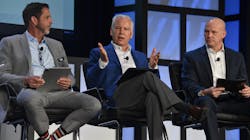A trio representing major component suppliers opened this year’s Heavy Duty Aftermarket Dialogue with some pithy characterizations of 2022:
“It was the best of the times, it was the worst of times,” said Jeffery Porter, president and CEO, Velvac.
“Managed chaos,” recalled Kent Jones, president – Americas, SAF‐Holland.
“We learned how to wear our dancing shoes,” suggested Rob Phillips, founder and CEO of Phillips Connect (and CEO of Phillips Industries).
The good news is that the COVID-19 pandemic, the supply chain and workforce challenges, and the geopolitical uncertainty of the past couple of years have taught the industry to be resilient, as the panel explained to several hundred attendees representing parts suppliers, distributors, and OEMs.
The takeaway from the “Real World View” session, part of a daylong event presented by MEMA and MacKay and Co.: Resilience will continue to be critical to business success going forward, because some of those recent challenges have yet to go away—and change is always just beyond the horizon.
China is out
Moderator Collin Shaw, MEMA’s chief commercial vehicle officer, began by questioning the panel about the impact of the recent emergence of COVID in China, following a restrictive domestic lockdown that greatly disrupted global trade.
“China has been a difficult place to do business in the last three years or so, since COVID really changed some of the assumptions that we had about the globalization that was taking place in the previous decade or so,” SAF‐Holland’s Jones said. “We're reevaluating many supply positions that were single-sourced in China, coming to us in the U.S. and into our company in Europe. It was highly disruptive to the supply chain.”
Additionally, trade has been challenged by container costs and tariffs, Jones noted.
Indeed, Phillips explained that China has lost the cost advantages that made sourcing so attractive there 20 years ago.
“We've shifted our manufacturing in China to focus on Southeast Asia, Australia. We set up in Vietnam to avoid some of the tariffs that are plaguing us from the China side,” Phillips said. “But the reality is we're looking at near-shoring. Everything is about moving closer, reducing inventories, improving quality levels and cycle times.”
Velvac’s Porter pointed out that “it still makes perfect sense” to support the domestic market in China with production in China but, otherwise, near-shoring works.
“In the last four or five years we've been trying to move as much of our component supply back to North America as possible,” Porter said. “Certainly events more recently, geopolitically, have added some urgency to that.”
Mexico is in
Phillips, with some enthusiasm, discussed how his decision to open a manufacturing facility in Mexico in 2007 is “probably the best decision” of his 20-year career.
“We're very bullish on Mexico: I'm a huge fan of the workers, the level of experience from the industry perspective. The college system is spectacular. So, we don't have labor issues—we have people that line up [for work],” Phillips said. “So, we've gone from a 32,000-sq. ft., 70-person plant to a half-million square feet now, and close to 1,700 employees. So that business has really taken off and we've continued to expand it. It is the cleanest factory that we have anywhere in the world and, in my opinion, the best managed and the best organized.”
See also: Strained supply chains prompt industrial nearshoring trends
And Phillips Connect is opening a facility across the street, to become the first telematics provider to manufacture in Mexico, he added. “So we’re going all in.”
Porter agreed, noting that Velvac has tripled its footprint “on both sides of the border” over the past five years.
“When we're looking at a key factors that influence where to put your production capacity—like availability and cost of labor, proximity to customers, proximity to supply base—I think all of those arrows point to Mexico as being a really good choice,” Porter said, and he emphasized the importance of a much more “mature” supply base in Mexico. “That's all allowed us to be more cost competitive; we're more responsive to our customers and have better control over quality at the same time.”
As to the importance of Mexico to parts manufacturers, Jones pointed out that almost 50% of the commercial trucks made in North America are built in Mexico, as are several leading trailer brands—“so it’s a growing market.”
Are the chips still down?
Moderator Shaw hesitated to bring the matter up, for fear of using “kind of a dirty word,” but he queried the panel about microchip supply, suggesting the shortage that has plagued many manufacturers in the commercial vehicle space since 2020 is finally “easing up.”
“I don't think it's completely eased, it’s just slightly better for all of us,” Jones said. “At this point, versus maybe a year ago, there are not 50 supply chain constraints causing problems, but there's still five—and those five were different a month ago, and they change and evolve into the next five. So there still are shortages and, in many cases, they are still very significant. But they're rotating and becoming a bit less.”
Again, the main chip problem is China, according to Phillips—or, specifically, “keeping the factories running” amid the government-mandated shutdowns.
“We're finding that it's easier to get chips when you're ordering a couple of hundred thousand at a time versus some of the automotive companies that are ordering 20 or 30 million,” he said.
See also: Divided Congress opens door for executive branch agenda, says MEMA
But, as a result of the shortage, Phillips has had to turn down other suppliers—but even an ever-so-slight difference in chip design means component and firmware changes downstream.
“With the challenges we’ve had for two and a half years, I think a lot of companies have gotten better at having secondary and tertiary versions of their products that are approved,” Phillips said.
More broadly, the panel were unanimous about the supply chain, or at least being able to manage it, in 2023: “cautiously optimistic.”
Ramping up for new tech
So how are suppliers and distributors preparing for some major technology shifts, such as vehicle electrification? Who’s going to train the fleets on adopting and adapting? Who is going to train the trainers?
In terms of commercial vehicles, electrification is “still rather immature,” Jones said—yet “it’s happening” and electric CVs are being delivered. But the impact on the aftermarket is not significant “at the moment.”
“I think there are good models that have existed in the aftermarket that the folks in this audience should pay close attention to during this transition,” Jones said, noting that he’s worked on electrification in some fashion for 15 years, and SAF-Holland currently offers electrified axles for trailers. “That transition from combustion engines—fuel systems, transmissions, drivelines—means all those components change significantly into high voltage electric motors, high voltage batteries, inverter software and cooling systems.
“However, I think it's very doable. I believe this industry needs to really look at what has happened in automotive. What are the types of service that are being done? What are the types of parts that are being consumed? And then shape our training around high voltage and around consumption of those parts over the next year. If you're running a powertrain shop, then you need to be prepared for this.”
See also: Preparing trucking's next generation of leaders
Phillips likewise emphasized the importance of training.
“There's a lot of work from us on the trailer side,” Phillips said. “How do you diagnose a trailer? How do you provide that guidance through a series of training videos? But make it easy and explain early on what the standard repair times should look like—there are companies like Noregon that do the same thing on the tractor side. That is going to be having a big impact in terms of easing this transition to electric vehicles.”
Connectivity and telematics are an essential aspect of running a successful fleet—but all that data can be a sore spot, and a way to lose customers.
“I think fleets are fearful,” Phillips said. “The fleets that we've seen move towards smart trailers get a lot of information, but it really comes down to the user interface—how you prepare all that information in a way that's very simple, very actionable.”
While Velvac has long been known as CV mirror supplier, the “visions solutions” provider offers camera systems as well—and a lot of the data being generated by vehicles today is video streaming data, Porter explained.
“Fleets are struggling with hundreds of gigabytes of video data and then be able to sue that efficiently for driving training and liability protection,” Porter said. “Velvac has pioneered the use of cameras for blind spot object detection, as sort of a smart sensor. And multiple smart sensors, in general, have allowed fleets to sift through those piles of data and grab information that was relevant much more quickly.”
E-commerce and the aftermarket
While any distributor and retailer must cope with Amazon’s impact on online shopping and delivery expectations, the simple truth is that 24/7/365 shipments aren’t possible if delivery vehicles aren’t on the road. So the heavy-duty aftermarket is facing tremendous pressure both to compete, and to support supply chain competition.
“With the improvements in onboard diagnostics, combined with the proliferation of vehicle telematics, there's already a trend toward that integration of vehicle data and diagnostics with the dealer networks,” Porter said. “As suppliers, in turn, we need to be able to supply real-time inventory views, cross-reference tools for parts replacements, seamless order entry, and so forth.
“One of the things we're doing at Velvac is to integrate our B2C and B2B systems, so that we can leverage visual data, easy-to-use parts lookup and cross-reference tools, and have that all anchored by robust EDI, file upload and integration systems. So, it is a challenge, and it's only going to become more data intense to improve that uptime.”
As a result, data aggregation has become a very attractive opportunity, Jones suggested, citing a number of commercial vehicle equipment suppliers who now offer data management platforms. And that’s to say nothing of the truck and trailer OEMs and their own systems.
“It's exciting,” Jones said. “It's exciting for the fleet operators who will figure it out. I don't know the outcome.”
The year ahead
Shaw wrapped up his questions by asking the panelists to name something to be nervous or excited about in 2023.
“Number one is order cancellations—that's one of those key drivers that could cause an eat into the backlog for new trucks and trailers, and that would also impact the aftermarket,” Phillips said. “Then for our business in Europe, I really carefully watch what's happening with Ukraine, because that's something that has had very negative impact on business throughout Europe.”
See also: Cummins and Meritor continue to merge fleet offerings
For Porter, COVID and supply chain disruptions—“for the third year in a row”—still make him nervous.
“But I'm really excited, particularly for this industry, the demand for vehicles and for aftermarket parts is still going to be really strong in 2023,” he said.
Jones, likewise, is excited about demand for vehicle and aftermarket parts—but he’s nervous about losing it.
“Because fleets are making money, they're spending it—because there’s freight to haul because the economy's still doing fairly well,” Jones said. “So I'm most nervous about the Fed rate, and what will happen as the Fed tries to strangle inflation out of the system, raising the rate higher and higher, and how that takes steam out of the economy. And then how does that trickle down into a hard or a soft landing?
“This industry is well known for overextending longer than it should in an economic environment, building to the very last truck or trailer even when it was not needed—and then having a plus/minus 30-50% swing.”
This article originally appeared on Fleet Maintenance.





